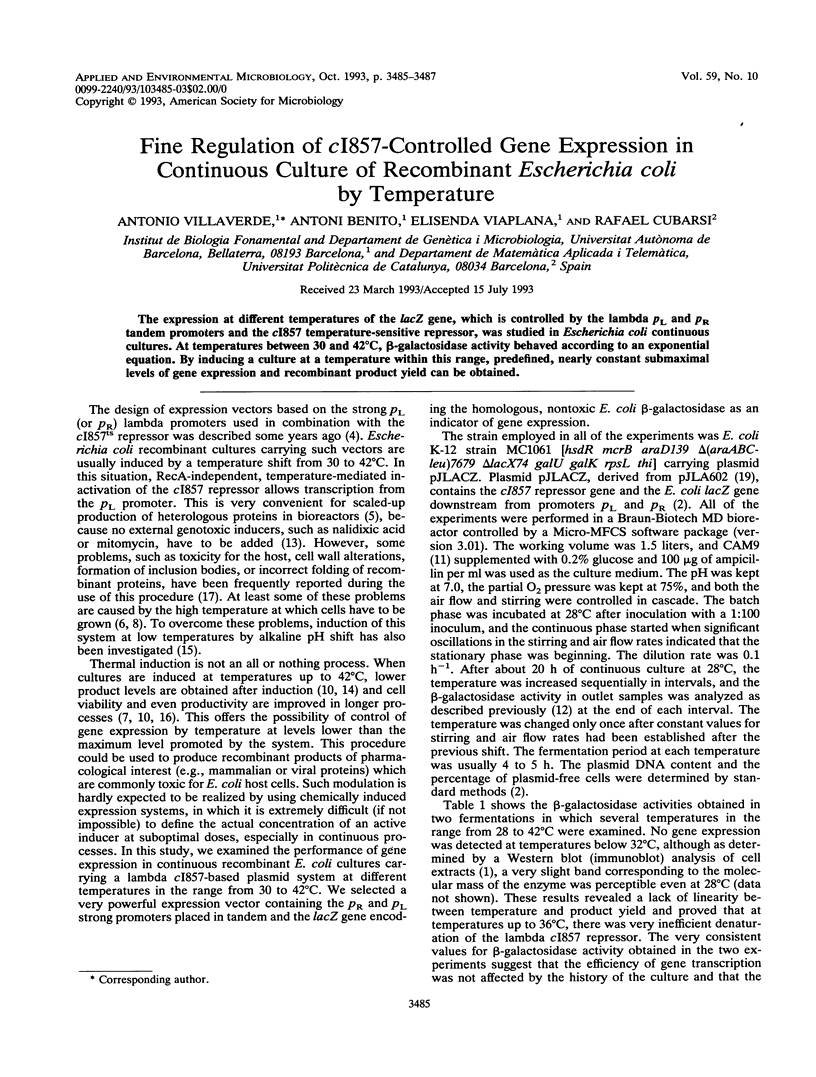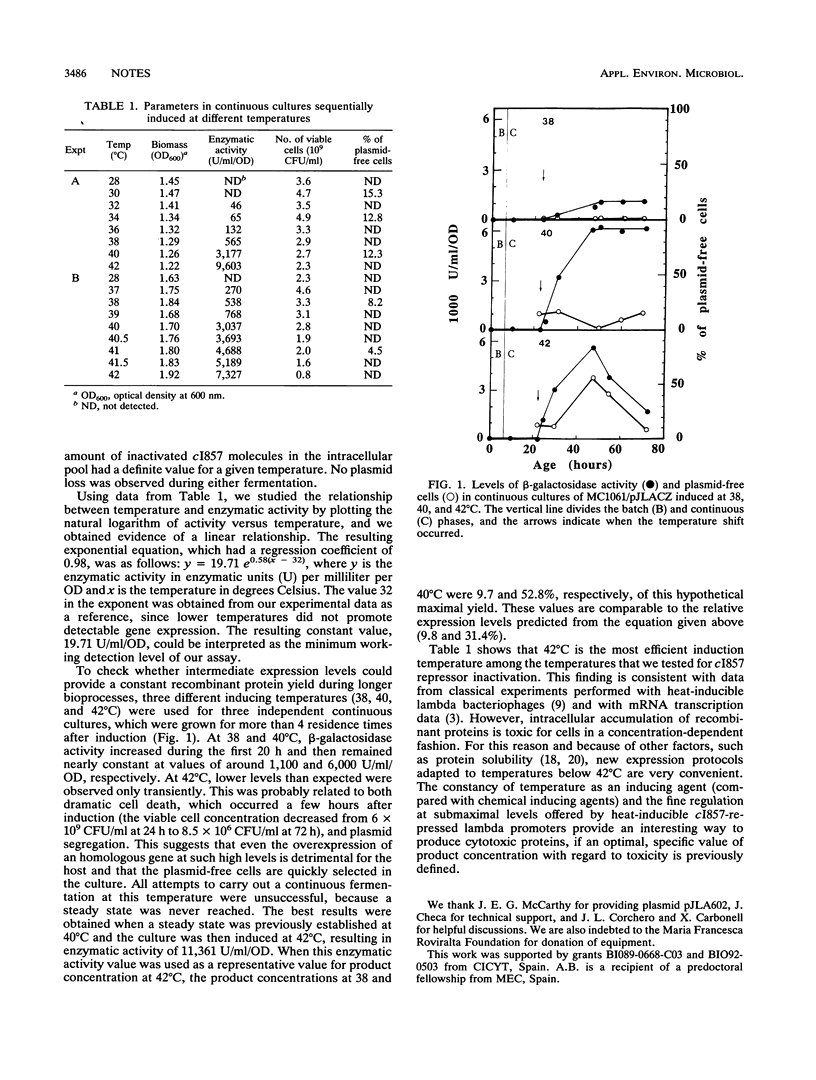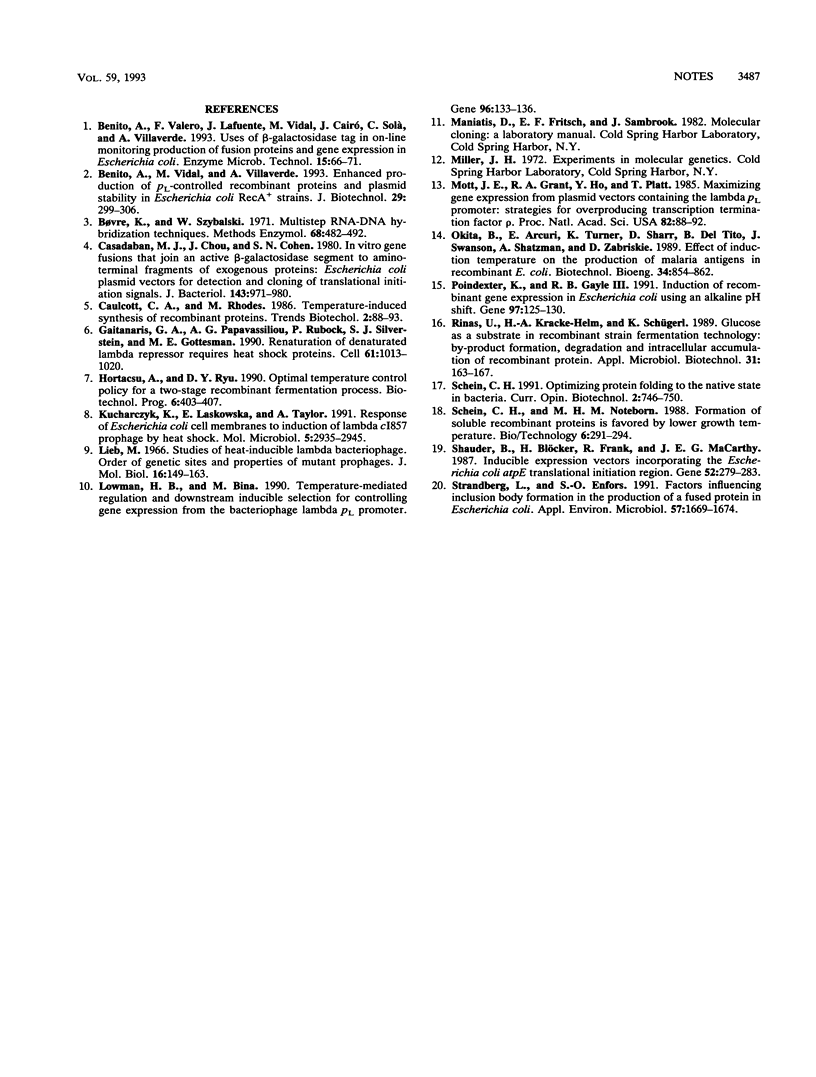Abstract
The expression at different temperatures of the lacZ gene, which is controlled by the lambda pL and pR tandem promoters and the cI857 temperature-sensitive repressor, was studied in Escherichia coli continuous cultures. At temperatures between 30 and 42 degrees C, beta-galactosidase activity behaved according to an exponential equation. By inducing a culture at a temperature within this range, predefined, nearly constant submaximal levels of gene expression and recombinant product yield can be obtained.
Full text
PDF


Selected References
These references are in PubMed. This may not be the complete list of references from this article.
- Benito A., Valero F., Lafuente J., Vidal M., Cairo J., Solà C., Villaverde A. Uses of beta-galactosidase tag in on-line monitoring production of fusion proteins and gene expression in Escherichia coli. Enzyme Microb Technol. 1993 Jan;15(1):66–71. doi: 10.1016/0141-0229(93)90118-l. [DOI] [PubMed] [Google Scholar]
- Benito A., Vidal M., Villaverde A. Enhanced production of pL-controlled recombinant proteins and plasmid stability in Escherichia coli RecA+ strains. J Biotechnol. 1993 Jun;29(3):299–306. doi: 10.1016/0168-1656(93)90061-q. [DOI] [PubMed] [Google Scholar]
- Casadaban M. J., Chou J., Cohen S. N. In vitro gene fusions that join an enzymatically active beta-galactosidase segment to amino-terminal fragments of exogenous proteins: Escherichia coli plasmid vectors for the detection and cloning of translational initiation signals. J Bacteriol. 1980 Aug;143(2):971–980. doi: 10.1128/jb.143.2.971-980.1980. [DOI] [PMC free article] [PubMed] [Google Scholar]
- Gaitanaris G. A., Papavassiliou A. G., Rubock P., Silverstein S. J., Gottesman M. E. Renaturation of denatured lambda repressor requires heat shock proteins. Cell. 1990 Jun 15;61(6):1013–1020. doi: 10.1016/0092-8674(90)90066-n. [DOI] [PubMed] [Google Scholar]
- Hortacsu A., Ryu D. D. Optimal temperature control policy for a two-stage recombinant fermentation process. Biotechnol Prog. 1990 Nov-Dec;6(6):403–407. doi: 10.1021/bp00006a001. [DOI] [PubMed] [Google Scholar]
- Kucharczyk K., Laskowska E., Taylor A. Response of Escherichia coli cell membranes to induction of lambda cl857 prophage by heat shock. Mol Microbiol. 1991 Dec;5(12):2935–2945. doi: 10.1111/j.1365-2958.1991.tb01853.x. [DOI] [PubMed] [Google Scholar]
- Lieb M. Studies of heat-inducible lambda bacteriophage. I. Order of genetic sites and properties of mutant prophages. J Mol Biol. 1966 Mar;16(1):149–163. doi: 10.1016/s0022-2836(66)80269-3. [DOI] [PubMed] [Google Scholar]
- Lowman H. B., Bina M. Temperature-mediated regulation and downstream inducible selection for controlling gene expression from the bacteriophage lambda pL promoter. Gene. 1990 Nov 30;96(1):133–136. doi: 10.1016/0378-1119(90)90353-s. [DOI] [PubMed] [Google Scholar]
- Mott J. E., Grant R. A., Ho Y. S., Platt T. Maximizing gene expression from plasmid vectors containing the lambda PL promoter: strategies for overproducing transcription termination factor rho. Proc Natl Acad Sci U S A. 1985 Jan;82(1):88–92. doi: 10.1073/pnas.82.1.88. [DOI] [PMC free article] [PubMed] [Google Scholar]
- Poindexter K., Gayle R. B., 3rd Induction of recombinant gene expression in Escherichia coli using an alkaline pH shift. Gene. 1991 Jan 2;97(1):125–130. doi: 10.1016/0378-1119(91)90019-8. [DOI] [PubMed] [Google Scholar]
- Schauder B., Blöcker H., Frank R., McCarthy J. E. Inducible expression vectors incorporating the Escherichia coli atpE translational initiation region. Gene. 1987;52(2-3):279–283. doi: 10.1016/0378-1119(87)90054-0. [DOI] [PubMed] [Google Scholar]
- Schein C. H. Optimizing protein folding to the native state in bacteria. Curr Opin Biotechnol. 1991 Oct;2(5):746–750. doi: 10.1016/0958-1669(91)90046-8. [DOI] [PubMed] [Google Scholar]
- Strandberg L., Enfors S. O. Factors influencing inclusion body formation in the production of a fused protein in Escherichia coli. Appl Environ Microbiol. 1991 Jun;57(6):1669–1674. doi: 10.1128/aem.57.6.1669-1674.1991. [DOI] [PMC free article] [PubMed] [Google Scholar]


